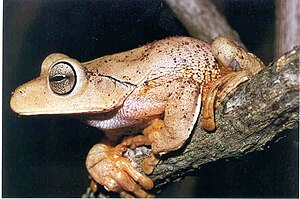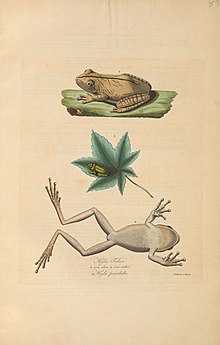Piston finger tree frog
| Piston finger tree frog | ||||||||||||
|---|---|---|---|---|---|---|---|---|---|---|---|---|

Piston finger tree frog |
||||||||||||
| Systematics | ||||||||||||
|
||||||||||||
| Scientific name | ||||||||||||
| Boana faber | ||||||||||||
| ( Wied-Neuwied , 1821) |
The piston-fingered tree frog ( Boana faber , Syn . : Hypsiboas faber ), also called blacksmith , is a member of the tree frog family . Its name is derived from the calls that sound like hammer blows on an anvil .
Appearance
The males of the piston-fingered tree frog reach a head-trunk length of 8.5 to 9.5 centimeters, the females of 9 to 10 centimeters. The animals are brownish-yellow to brown in color. The belly is yellowish or white. On the back and legs there are more or a few small black spots, in some specimens none at all. There are detention organs on all toes.
habitat
This species occurs in Brazil, there in the states of Pernambuco and Rio Grande do Sul as well as in the Mata Atlântica and in the Cerrado . In Paraguay it can be found in the southeast, in Argentina in the province of Misiones . The blacksmith lives in the forests, parks and gardens near swamps and other bodies of water.
Way of life
The piston-fingered tree frog feeds on smaller insects, worms, and crustaceans. He is mostly in trees.
Reproduction
During the breeding season, the males dig up to 10 centimeters deep pits at the edge of smaller pools or larger puddles. With the help of their forelegs, they then build a 10 centimeter high mud dam around this waterhole. They carefully smooth the inner walls of the watertight pool created in this way with their fingers. During the mating season, the males emit loud noises at night that are reminiscent of hitting a hammer on a blacksmith anvil to attract a female to mate.
After successful mating, the female lays numerous small eggs in the pond. The eggs are black on the top and light on the underside. They cover the surface of the water as an egg film. The tadpoles feed on plant remains and dead animal material. It takes several weeks to develop into a frog. After the metamorphosis , the frogs are already 35 millimeters long.
Hazards and protective measures
Since this species is relatively widespread and no specific threats are known, the IUCN classifies it as ( Least Concern ) not endangered.
Systematics and taxonomy
The frog was of Prince Maximilian of Wied-Neuwied in his 1821 report published travel to Brazil in the years 1815 to 1817 first described . Maximilian zu Wied-Neuwied called it Hyla faber . Although there is no preserved type specimen , there is an illustration in volume 7 of Wied-Neuwied's illustrations on the natural history of Brazil , published in 1824. The species was later placed in the genus Hypsiboas , but in The name Boana was proposed by Alain Dubois in 2017 . The Amphibian Species of the World database has already adopted this correction.
Individual evidence
- ↑ Hypsiboas faber . AmphibiaWeb, with audio samples of the calls of the frog (MP3), accessed on February 25, 2018
- ↑ Bruno Pimeta, Danielle Costa, Roberta Murta-Fonseca, Tiago Pezzuti: ANFIBIOS . Bicho de Mato, Belo Horizonte 2014, p. 92.
- ↑ Axel Kwet: Schmied, Kolbenfinger-Laubfrosch kwet.de, 2003, accessed on February 25, 2018.
- ↑ Hypsiboas faber in the IUCN Red List of Threatened Species 2017.3. Posted by: Esteban Lavilla, Lucy Aquino, Axel Kwet, Diego Baldo, 2008. Retrieved February 24, 2018.
- ^ Maximilian zu Wied-Neuwied : Travel to Brazil in the years 1815 to 1817. Vol. 2. Verlag Henrich Ludwig Brönner, Frankfurt am Main 1821, p. 249 (first description).
- ↑ Alain Dubois: The nomenclatural status of Hysaplesia, Hylaplesia, Dendrobates and related nomina (Amphibia, Anura), with general comments on zoological nomenclature and its governance, as well as on taxonomic databases and websites. Bionomina, pp. 1–48, March 2017 doi: 10.11646 / bionomina.11.1.1 .
- ^ Darrel R. Frost: Boana faber (Wied-Neuwied, 1821) . In: Amphibian Species of the World: an Online Reference. Version 6.0. American Museum of Natural History, New York 1998–2018, accessed February 25, 2018.
literature
- Jiří Felix (ed.), Alena Čepická: America's fauna in color. Translated from the Czech by Jaroslav Konšal. Karl Müller Verlag, Erlangen 1989, p. 85.
- Axel Kwet: O ferreiro, the blacksmith - biology of a remarkable tree frog. In: Reptilia. Volume 3, No. 14, 1998, pp. 62-67.
- Axel Kwet: Frogs in the Brazilian Araucaria Forest - Anurs Community of the Araucarias Forest of Rio Grande do Sul: Diversity, reproduction and resource allocation. Natur und Tier-Verlag, Münster 2001.
- Maximilian zu Wied-Neuwied : Journey to Brazil in the years 1815 to 1817. Volume 2, Henrich Ludwig Brönner, Frankfurt am Main 1821, p. 249 (first description).
Web links
- Darrel R. Frost: Boana faber (Wied-Neuwied, 1821) . In: Amphibian Species of the World: an Online Reference. Version 6.0. American Museum of Natural History, New York 1998–2018, accessed February 25, 2018.
- Hypsiboas faber inthe IUCN Red List of Endangered Species 2017.3. Posted by: Esteban Lavilla, Lucy Aquino, Axel Kwet, Diego Baldo, 2008. Retrieved February 24, 2018.

